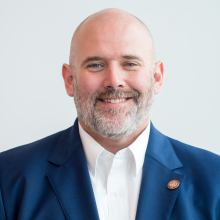Valuing Flexibility: Chronicling a Year of Office Changes

In-person? Remote? Hybrid? Over the course of 2022, as I attended meetings with colleagues in the field, conversations would inevitably shift to our approach to work as restrictions eased. Would the institution require everyone back in the office five days a week? What about a three in, two out model? Is anyone thinking about permanent remote positions?
More and more I am thinking about how to attract and retain passionate and talented people and consistently deliver on our work, and such questions of flexibility are top of mind. What was once seen as a perk or simple employment negotiation has now become a global conversation to support workers work-life balance, mental health, and personal needs. Flexibility in remote work impacts more than a bottom line: it reflects the responsive culture of an organization, the willingness to create space for differing employee needs, and a belief that change can improve the well-being of one’s institution.
These conversations now pervade the professional space in international education. As we look to private industry and other sectors, results are mixed. Corporate decision-makers who pronounce a full return to work make headlines, as do those who tout the realized benefits of hybrid or full remote modalities. There doesn’t seem to be a one-size-fits-all prescription to solve for all variables, but initial research would suggest clear gains in the hybrid column.
The cultural and operational shifts we experienced in the past two plus years highlighted opportunities previously not considered, or thought to be unattainable, when in fact many were easily adopted and may be beneficial in the long term. The possibility of piloting or adopting a hybrid work model in an office supporting international students and scholars may have been unheard of in the field, but is quickly becoming more common in review of job listings and speaking with job seekers.
What We Tried—and What Worked
At the Office of International Affairs at University of Chicago, we piloted a hybrid approach for a year before making decisions about how to proceed in the long term. The plan seemed simple: two days on campus and three days from home, with a once monthly all-team, in-person gathering (the third Friday of each month). As new team members start, they begin a 12-week onboarding and training process that has them in five days a week before moving to the hybrid model.
Our pilot year flew by, and at midpoint we took stock of how it was going. Through an anonymous survey, the team reported a greater sense of trust, accountability, and enhanced morale. Offering flexibility means our time together is more purposeful, and supports a healthier quality of life without sacrificing productivity.
Noted additional benefits included increased advising capacity and more intentional programmatic engagement and outreach. Wait times for advising appointments dropped as advisers offered a blend of scheduled appointments and drop-in advising virtually. Time previously spent finding suitable space on-campus to hold orientation sessions, employment workshops, and training for our campus partners was better spent on content and communication. We found we were reaching more people who hadn’t previously utilized our services, and by the end of the year we had data pointing toward increased utilization and continued engagement by those we were serving.
At the end of our pilot, it was clear the benefits warranted consideration of long-term implementation. As we race into the second year, we find ourselves utilizing the flexibility offered as an incentive to fill vacant and new positions.
Of course, this alone is not the only variable possible applicants consider when thinking about new opportunities. To remain competitive, we must review compensation offerings and opportunities for growth both in terms of skill and upward mobility. However, continuing with a hybrid approach meant we would retain the benefits of flexibility: improved quality of life for the team (and arguably those we are serving) and increased productivity and creativity.
Applying Our Learnings
Beyond modality, the past year has given us a chance to think about how we communicate, interact with, and support the students and scholars we serve. Do we bring back walk-in advising hours? Do students and scholars want to walk to our office for those services? What about supportive programming?
We learned from our students and scholars initially they would like the choice of whether to see someone in person or schedule a virtual appointment, so we offered both options. While those options remain, what quickly emerged was clear preference for accessibility online. One-on-one advising appointments via Zoom were filling up weekly—often beyond the scheduling capacity of an adviser. So, we adapted by offering “quick question advising,” allowing students to drop into a Zoom room, be placed in a waiting room (in queue to estimate a wait time), and be seen on a first-come, first-serve basis.
Nothing is ever as simple as a quick question, but offering a blend of one-on-one appointments and drop-in virtual advising seemed to shore up the advising needs for our students and scholars and provide flexibility to those advising them. We’ve yet to look at early morning or late evening offerings specific to advising, but we do hold program-specific sessions during off-hours to accommodate time zone differences. In summer 2022, we spent time focusing on our programmatic offerings and how to cultivate a more interpersonal connection with our students and scholars.
We’ve learned a lot over the course of the past 2 years, and we will no doubt continue to refine our tactics moving forward. Our work and how we approach it in terms of workforce and workplace won’t likely return to how things used to be. For now, we continue to debate and test our approach to the work we do with greater awareness and care for those doing it. •
Nick Seamons is the executive director and assistant dean of students at University of Chicago's Office of International Affairs.
About International Educator
International Educator is NAFSA’s flagship publication and has been published continually since 1990. As a record of the association and the field of international education, IE includes articles on a variety of topics, trends, and issues facing NAFSA members and their work.
From in-depth features to interviews with thought leaders and columns tailored to NAFSA’s knowledge communities, IE provides must-read context and analysis to those working around the globe to advance international education and exchange.
About NAFSA
NAFSA: Association of International Educators is the world's largest nonprofit association dedicated to international education and exchange. NAFSA serves the needs of more than 10,000 members and international educators worldwide at more than 3,500 institutions, in over 150 countries.
NAFSA membership provides you with unmatched access to best-in-class programs, critical updates, and resources to professionalize your practice. Members gain unrivaled opportunities to partner with experienced international education leaders.















